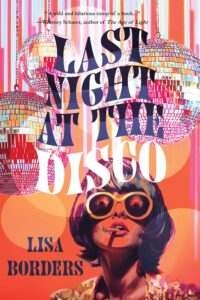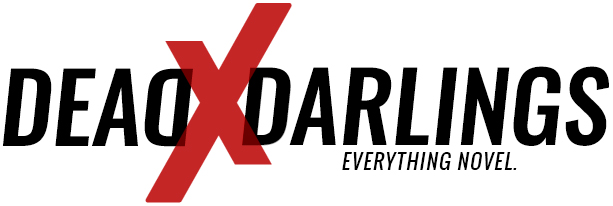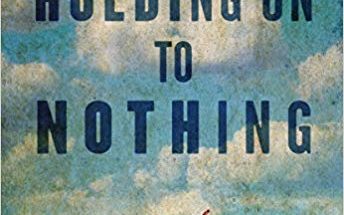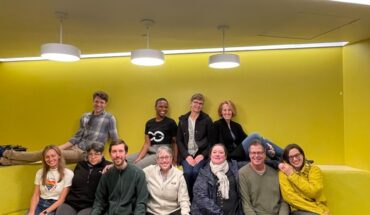 Following up on her critically acclaimed novels The Fifty-First State and Cloud Cuckoo Land, Lisa Borders’ latest release Last Night at the Disco transports us to late-70’s New Jersey, where a junior high school teacher who spends her weekends at Studio 54 discovers two musicians who will become among the most influential artists of the 1980s – and decades later, having burned bridges with them both, tells her story in hopes of securing her rightful place in rock ‘n’ roll history. Lisa, a beloved and influential instructor in the New England writing community who co-founded Grub Street’s Novel Incubator, took time out from her busy launch schedule to speak with me.
Following up on her critically acclaimed novels The Fifty-First State and Cloud Cuckoo Land, Lisa Borders’ latest release Last Night at the Disco transports us to late-70’s New Jersey, where a junior high school teacher who spends her weekends at Studio 54 discovers two musicians who will become among the most influential artists of the 1980s – and decades later, having burned bridges with them both, tells her story in hopes of securing her rightful place in rock ‘n’ roll history. Lisa, a beloved and influential instructor in the New England writing community who co-founded Grub Street’s Novel Incubator, took time out from her busy launch schedule to speak with me.
Marc Foster: Lynda Boyle – wow!! She’s what my mother-in-law would call a “piece of work,” a narcissistic manipulator, yet it’s hard to look away: the reader gets hooked on finding out what schemes she’ll dream up next. Where did Lynda come from, and what choices did you make in characterizing her?
Lisa Borders: When I was in my twenties and early thirties, I was often drawn to people I used to think of as peacocks: gorgeous, fascinating to talk to, and, if you scratch below the surface, utterly self-centered. Some of them were men, but I was always more intrigued by the women. They situated themselves in a society that was constantly telling women they needed to put others’ needs first, and I couldn’t help but admire them, even if these friendships ultimately ended in disappointment. I don’t think any of the people I knew back then were full-blown narcissists the way Lynda is – or if they were, they hid it better than she does! – but they certainly had some of her characteristics.
When creating a character who’s as over the top as Lynda is, it can be challenging to decide how far she will go. I decided early on that Lynda (adult Lynda, anyway!) is never cruel just to be cruel. She lashes out, sometimes quite spectacularly, when she feels hurt or slighted; she manipulates to get her own way; but she’s not generally cruel for sport. She goes too far in many situations, but I didn’t want her to go so far that the reader couldn’t enjoy watching her in action.
Your previous novels The Fifty-First State and Cloud Cuckoo Land offer affecting portraits of life in New Jersey, and the music scene, respectively. What drew you back to New Jersey, and pop music, for Last Night at the Disco?
Well, you can take the girl out of Jersey, but you can never take the Jersey out of the girl. I grew up in both Central and South Jersey, two regions that, despite being right next to each other geographically, feel worlds apart. The Fifty-First State was my rural South Jersey novel, but Disco is all Central Jersey.
When you live in the shadow of New York City, as folks in Central Jersey do, it’s not hard to develop a bit of an inferiority complex, even though most of us New Jerseyans would never admit it. In his generous blurb of my book, Tom Perrotta described Lynda as having a “Jersey-sized chip on her shoulder,” which I think gets perfectly at the root of much of her inner turmoil. Tom, by the way, is from New Jersey, too.
I seem to have difficulty writing about a place where I’m currently living. Setting is very important in all of my books, but I need some temporal distance to be able to see different facets of a locale. For example, I lived in Somerville, Massachusetts, for 20 years, and moved out in 2018. For a very long time I wanted to write something set there, but I was only able to start work on that book in the last year.
Last Night at the Disco is framed in the form of a letter from Lynda to Jann Wenner, co-founder of Rolling Stone, and is meant – from Lynda’s perspective – to correct misconceptions and settle scores. How did you land on this structure? Can you talk about the challenges and opportunities in moving back and forth between foreground and background?
Plot and structure are the most difficult aspects of writing a novel for me personally. As a result, I tend to discuss plot issues with my writer friends and my agent. Not that I don’t discuss other craft issues too, but it often seems like many of the “a-ha!” moments I have with plot or structure are suggested to me by early readers.
In this case, my friend and author Christopher Castellani had read a very early draft of the first 50 or so pages of Last Night at the Disco. In that version, Lynda was just blabbing her story out to no one in particular, from an unspecified point in time. Chris suggested that I have Lynda tell her story directly to someone, so that the narrative tension could be driven by her desire to persuade or impress whomever she was telling the story to. I can’t remember the exact chronology here, but once I came up with a Rock & Roll Hall of Fame induction scene featuring two musicians she’d known decades earlier as the catalyst for Lynda to tell her story, I decided she would want to talk directly to Jann Wenner. The co-founder of both Rolling Stone magazine and the Rock Hall of Fame, Wenner is a larger-than-life figure in his own right and would definitely have been on Lynda’s radar.
My agent at the time I was writing this book was Esmond Harmsworth. You may know that he passed away in April this year – a great loss to the literary world, and a very personal loss to those of us lucky enough to be his clients/friends. Esmond was instrumental in helping me with the dual timeline after he read the first draft. Once I decided Lynda was telling the story to Jann four decades later, I had worked out some details of where she was living and who she was with, but mostly the 2019 timeline was just scaffolding. Esmond suggested I have a subplot with Lynda’s neighbors play out in the later timeline, to add some tension to the middle of the book. It was a great idea, and I had a lot of fun writing those scenes.
Initially I intended the later timeline to be closer to whatever year my book came out, but I ended up making it 2019 so that I didn’t have to deal with the pandemic. But also, I think it gives the reader something to think about in the end, wondering how Lynda will navigate what we know is coming.
Throughout the novel, Lynda uses her sex appeal – body, clothing, perfume – to get what she wants and extricate herself from jams. In that regard, you portray her as being ruthless with boyfriends who don’t measure up to high standards. Can you talk about the tension between feminist agency and using/abusing the “male gaze,” in this regard?
This is a great question, as I see a clash between different waves of feminism as one of the undercurrents in the book. Second Wave feminism would have arrived in the 1960s when Lynda was an adolescent, but as a girl in a small town who got most of her positive reinforcement for her own beauty, she rejected feminism as something she didn’t need. She says this overtly at one point in the novel. And there were lots of women like this, women who felt their lives were so tied to their husbands’ that they rejected feminism as “going too far.” I remember when I was about five or six years old, my mom sort of rolling her eyes at the idea of women “burning their bras” – which became a derogatory catch phrase used by anyone who was against the women’s movement, but was in fact a real event held to protest the Miss America pageant in 1968.
In my novel, Lynda’s student, Aura, just twelve years her junior, would have grown up in a time when Second Wave feminism was already actively securing a number of rights for women: the right to reproductive freedom via Roe v. Wade, for example, and financial independence via the Equal Credit Opportunity Act. But there was still work to do, and as a musician, a teenage Aura sees the blatant sexism in the music industry. When she begins her own musical career in the 1980s and 90s, calling out misogyny becomes her trademark. I see her as being one of the early Riot Grrls and embracing Third Wave feminism.
When I think of Lynda through this lens, there’s something tragic about her. She’s very smart, but she ends up chasing an elusive and ultimately shallow notion of fame. I think the most feminist thing she does, and she does this repeatedly, is to use the male gaze to her advantage. I’m not saying all of the men she treats badly deserved it! Some of them absolutely did not. But she was also used by a lot of men, particularly in the East Village poetry scene.
The emotional heart of Last Night at the Disco takes place in the late-1970’s, during a transition between the disco and rock eras, a period of incredible innovation in popular music here in the U.S. What led you to zero in on that moment, and what did you learn, or re-learn, along the way?
The setting, in terms of both place and time, was truly the impetus for writing the novel. New York City in the late 1970s was such a nexus for different forms of music: the waning days of the early glam rock scene, disco in its heyday, and the beginning of punk rock. I’m about the same age as Aura, but I did not have the kind of access to what was happening in the City that she has. I started out 1977 as a huge fan of Jackson Browne and Bruce Springsteen, but by the time I graduated from high school in 1980, I had expanded my musical palate to include artists like Blondie, Talking Heads, Kate Bush, Elvis Costello, Squeeze.
A strange musical footnote of that era is the “Disco sucks!” movement. The anti-disco movement was started by white rock deejays who felt their livelihoods threatened as disco gained popularity, and it’s clear to me today that this absurd war on disco was driven by both racism and homophobia. But I was a teenager in a small town during the height of the disco vs. rock wars, young and sheltered enough to not understand the deeper implications. I thought I had to choose, and I chose rock.
Decades later, as I researched disco music for my novel, I learned something that surprised me: I loved it! As I began playing Donna Summer and Gloria Gaynor, Chic and the Commodores, I could feel how joyous, uplifting and infectious the music was. Better late than never!
You’ve been an instructor in the New England writing community for years. What role does teaching play in your writing practice nowadays?
I love teaching, and it’s hard for me to imagine being a writer without flexing that particular muscle. In searching for a solution to a craft issue in a student’s manuscript, I often learn something that allows me to come at my own work a different way. I also really enjoy the camaraderie of a workshop. Perhaps the only good thing to come out of the pandemic was Zoom, which gave me the ability to launch my Novel Reactor classes and run them from my home.
What’s next?
Getting Last Night at the Disco launched in the short term, of course! Longer term, I am hoping to teach more in 2026, and I’m excited that I’ll be starting next year off by teaching a new class at the new TBR Writing and Publishing Conference in Cambridge. And there is a new novel, another dark comedy, but it’s still in that delicate stage where I don’t like to talk about it too much.
Lisa Borders is the author of the novels Cloud Cuckoo Land, chosen by Pat Conroy as the winner of River City Publishing’s Fred Bonnie Award and a Massachusetts Book Awards honoree, and The Fifty-First State. A frequent humor contributor at McSweeney’s, her essays and short fiction have appeared in Past Ten, The Rumpus, Cognoscenti, Black Warrior Review and other journals. She has received grants from the Massachusetts Cultural Council, the Somerville Arts Council and the Pennsylvania Council on the Arts, and residencies at the Millay Colony, Virginia Center for the Creative Arts, Hedgebrook, Blue Mountain Center and St. Nell’s.




1 comment